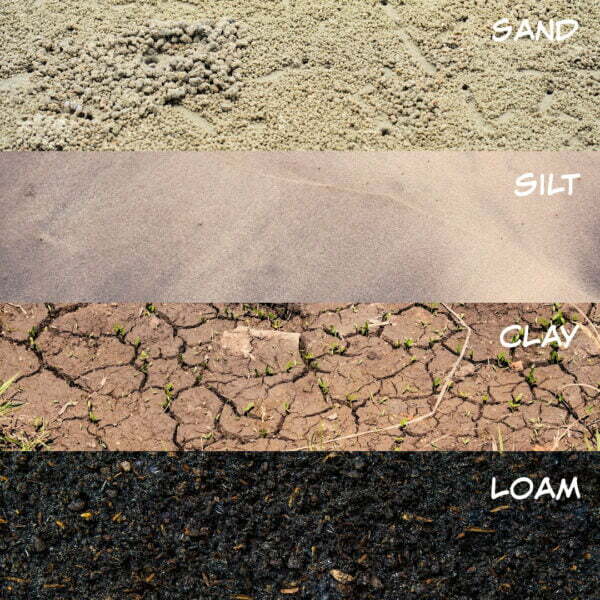What Kind of Soil Do I Have?
Plants need good soil for healthy growth and productivity. Well-prepared soil is the foundation of your entire lawn and garden—and gives you a jump-start on the growing season! But sorting through the various lawn and garden solutions can be daunting. How can you determine what product will work best?
Let’s start by learning more about YOUR soil.
The Different Types of Soil

- How water drains
- How much oxygen plant roots get
- How well the soil holds nutrients
- How quickly the soil will erode
Clay Soil is made up of very fine particles that are slow to drain and hold too much water. While it holds nutrients well, it is sticky and can become compacted easily, limiting oxygen flow to the plant roots. In the heat of summer, clay soil can “bake” and become very hard. When soils are this “tight” due to clay, the necessary air, water, and nutrients cannot move through the soil or be accessed by plant roots. Roots become stunted and grass becomes stressed, weakened, and more prone to thatch, disease, insects, and even weeds. If you’re plagued by clay or compacted soil, try Aerify Plus to break apart the clay bonds and add organic matter back to the soil.
Sandy Soil warms up quickly in spring, but it is heavy and drains too quickly to absorb nutrients very well. Nutrient deficient sandy soil leads to thin, weak, discolored grass. Plants growing in this kind of soil dry out faster, too, and are often unable to produce crisp or flavorful vegetables. Since there’s nothing for the soil biome to feed on in sandy soil, pests and disease can become an issue as well. Applying Nature’s Magic to sandy soil adds concentrated organic matter to the soil while increasing nutrient absorption, stimulating earthworm activity, detoxifying soil, and improving plant resistance to disease, insects, and weather stress.
Silty Soil holds on to moisture and nutrients for longer, but light silt particles are more prone to erosion. Silt particles are sized somewhere between clay (extremely fine) and sand (granular), and can be beneficial in a soil mix for certain kinds of plants that like to be well-drained.
Loam is the ideal soil texture that consists of equal parts clay, sand, and silt, and an ample amount of humus. It holds moisture but also drains well, is fertile, easy to work with, and contains plenty of organic matter to feed the soil biome and the plants that grow in it.
The easiest way to identify your soil type is to simply feel it by rubbing a moist sample between your fingers. Clay soil will feel sticky; sandy soil will feel gritty; silty soil will feel smooth. Good loam soil will easily crumble between your fingers and not form a hard ball.
Soil Testing
Testing your soil in the spring is a great way to determine your soil type, pH levels, and what nutrients are missing. You can purchase soil test kits in garden stores or online, but for a more advanced analysis of your soil you’ll need to send a sample to a lab (this test comes highly recommended by several lawn care professionals). Once you know what you’re working with, you can take steps to improve your soil.
One of the easiest things to test for is soil pH. Soil pH affects how well plants can access, absorb, and utilize nutrients and minerals in the soil. A pH ranging from 6.0 to 7.0 is ideal for most lawns and gardens. You can get simple soil pH testers from your local garden shop that will tell you if your soil is too acidic (or, less frequently, too alkaline). If you find your soil is on the acidic side, an application or two of Liquid Lime will help raise the pH and unlock nutrients in the soil while providing valuable calcium to your lawn and garden. For soil that is too alkaline, Liquid Iron can be of benefit, but it is difficult to acidify soil quickly. In such instances, applications of Humic Acid help unlock nutrients bound up by pH imbalances and make them available for absorption.
A lab soil test can also let you know if your soil is deficient in macronutrients (NPK: Nitrogen, Phosphorus, Potassium) or Micronutrients such as Magnesium, Zinc, Iron, Manganese, Boron, Molybdenum, and Sulfur. Some lab soil tests even test for lead, metals, and pesticides, which you will want to be informed about if you plan on growing an edible garden.
Now that you know more about your soil, it’s time to get growing!
All of our products are non-toxic and safe for both pets and children. If you have any questions about your lawn or garden, please don’t hesitate to reach out!
This post may contain affiliate links.


